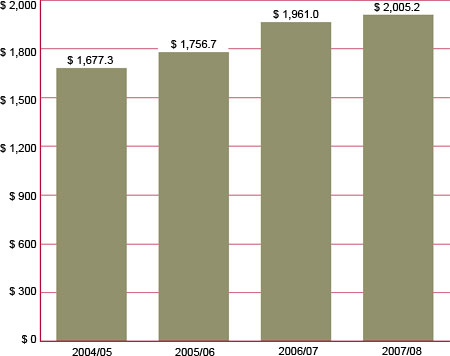Non-Insured Health Benefits Program - 2004-2005 Annual Report
3 The Envelope Environment
 The
Non-Insured Health Benefits (NIHB) Program operates within the fiscal
environment of the First Nations and Inuit Health Program. The latter
Program includes the First Nations and Inuit Health Program Envelope
plus resources approved for specific initiatives. This represents the
maximum resources available to fund all federal First Nations and Inuit
Health Programs. The
Non-Insured Health Benefits (NIHB) Program operates within the fiscal
environment of the First Nations and Inuit Health Program. The latter
Program includes the First Nations and Inuit Health Program Envelope
plus resources approved for specific initiatives. This represents the
maximum resources available to fund all federal First Nations and Inuit
Health Programs.
The 1995 Budget set growth levels for the envelope at 3% in 1997/98.
The 1996 Budget set envelope growth for 1998/99 at 3% less $20 million.
Annual envelope growth for the period 1999/2000 to 2001/02 was set at
3%. The 2002, 2003 and 2004 Budgets approved resources to rebase the
NIHB funding levels by approximately $100 million in 2002/03, $151.2
million in 2003/04 and by $189.7 million in 2004/05.
The NIHB Program's expenditures account for over 47.6% of total envelope
expenditures. Other programs include:
- Health Services resources for community nursing, National Native
Alcohol and Drug Abuse Program (NNADAP), Solvent Abuse, mental health,
Brighter Futures, transfer initiatives and management/support at the
zone, regional and Headquarters (HQ) levels; and
- Hospital Services resources for the operation of First Nations and
Inuit Health Branch (FNIHB) hospitals.
The information that follows in this section demonstrates the overall
impact of the envelope and the significance of the Non-Insured Health
Benefits Program to any strategy to manage within the envelope.
Figure 3.1
First Nations and Inuit Health Programs ($ Million)
2004/05 to 2007/08
In 2004/05, resources within the First Nations and Inuit Health Programs
totalled $1,677.3 million. These resources are projected to grow to $2,005.2
million by 2007/08 subject to parliamentary approval of appropriations.
Total resources, as shown in this report, vary slightly from those in
the 2003/04 Annual Report as a result of some minor financial adjustments.
Resource increases are largely due to new program funding initiatives;
e.g. sustainability, water, immunization, etc.
Total resources consist of envelope funds growing at 3% and non-envelope
funds.
These statistics originate from the Main Estimates representing approved
resources.

Source: FIRMS adapted by Program Analysis Division
Figure 3.2
First Nations and Inuit Health Programs ($ Million)
2005/06 (Estimates)
In 2005/06, the available resources for the First Nations and Inuit
Health Programs Envelope are set at $1,756.7 million. Total resources
for the NIHB Program, both operating and contributions, account for $837.0
million (47.6%) compared to $895.7 million (51.0%) for Health Services.
Health Services resources are for direct First Nations and Inuit management
of health programs including community nursing, alcohol/drug counselling,
Brighter Futures, transfer initiatives and management/support at the
zone, regional and HQ levels.
Hospital Services resources account for $24.0 million (1.4%) and are
used for the operation of FNIHB hospitals.

Source: FIRMS adapted by Program Analysis Division
|
